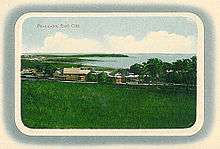Beidaihe District
| Beidaihe 北戴河区 | |
|---|---|
| District | |
| Beidaihe District | |
|
Beidaihe Station | |
| Coordinates: 39°50′05″N 119°29′04″E / 39.83472°N 119.48444°ECoordinates: 39°50′05″N 119°29′04″E / 39.83472°N 119.48444°E | |
| Country | People's Republic of China |
| Province | Hebei |
| Prefecture-level city | Qinhuangdao |
| District seat | Xishan Subdistrict (西山街道) |
| Area | |
| • Total | 70.14 km2 (27.08 sq mi) |
| Elevation | 13 m (42 ft) |
| Population (2008) | |
| • Total | 66,000 |
| • Density | 940/km2 (2,400/sq mi) |
| Time zone | China Standard (UTC+8) |
| Website |
www |
Beidaihe District (simplified Chinese: 北戴河区; traditional Chinese: 北戴河區; pinyin: Běidàihé Qū; Wade–Giles: Pei Tai Ho) is a popular beach resort and a district of the city of Qinhuangdao, Hebei province on China's Bohai Sea coast. It has an area of 70.14 km2 (27.08 sq mi) and, as of 2008, a population of 66,000, as well as a coastline of 22.5 km (14.0 mi).[1] It is also known as a birding haven.
The Beidaihe Beach Resort stretches 10 km from east to west, from the Yinjiao Pavilion to the mouth of the Daihe river. The beach itself is covered with fine yellow sand stretching some 100 meters to the sea. The water is shallow. Mount Lianfeng near the beach has two peaks covered by abundant green pines and cypresses. Lush vegetation, caves, decorated pavilions, secluded paths and winding bridges have made it attractive to visitors from throughout China.
English railway engineers were the first Europeans to discover the fishing village in the 1890s and it was not long before wealthy Chinese and foreign diplomats from Beijing and Tianjin made the village a popular destination.

Use by Communist Party
Because of its proximity to the capital, Beidaihe has been the location of many important official conferences, and has become well known as the Communist Party of China's summer retreat. It is still commonly used by the Party's highest leadership each July to slip away from the summer heat of Beijing and to plan important strategies in the privacy Beidaihe offers. "Beidaihe," an American diplomat once said, "is China's 'smoke-filled room.'"[2] These conferences have been abandoned due to an order from Hu Jintao in 2004, mainly for two reasons. First, a conference in a resort area appeared to contradict Hu and Wen Jiabao's goal in projecting a frugal image for the party. Second, it is a desire of the leadership under Hu to work through formal party and state mechanisms rather than informal gatherings.[3]
After Mao Zedong led the Communists to power in 1949, the new rulers also developed a taste for seaside atmosphere. Mao himself had a summer resort here. Sanatoriums sprang up to reward the efforts of model workers from every industry. A very large Friendship Guesthouse was constructed in 1954, one of dozens across China, to receive the Soviet "elder brothers" who came to assist Chinese development prior to tensions emerging between Soviet and Chinese leadership.
The most infamous event which occurred here involved Lin Biao, who on 13 September 1971, after he was accused of plotting a coup, fled his villa here with his wife and a son and boarded a plane for the Soviet Union at the local airport; the plane crashed in Mongolia, killing everyone on board.[4]
Administrative divisions
There are two subdistricts and two towns in Beidaihe.[5]
Subdistricts:
- Xishan Subdistrict (西山街道), Dongshan Subdistrict (东山街道)
Towns:
- Haibin (海滨镇), Daihe (戴河镇), Niutouya (牛头崖镇)
References
- ↑ (Chinese) Profile of Beidaihe District, Official website of the Qinhuangdao People's Government, accessed 2008-04-17.
- ↑ Ignatius, Adi (September 27, 1999). "Working Vacation on the Beach". Time (magazine). Retrieved August 16, 2015.
- ↑ Kahn, Joseph (August 4, 2003). "Chinese Leader Cancels Communists' Seaside Retreat". The New York Times. p. A2. Retrieved 12 December 2009.
- ↑ Edward Wong and Jonathan Ansfield, "China’s Communist Elders Take Backroom Intrigue Beachside," New York Times, July 21, 2012; retrieved July 22, 2012.
- ↑ 2011年统计用区划代码和城乡划分代码:北戴河区 (in Chinese). National Bureau of Statistics of the People's Republic of China. Retrieved 2012-07-21.
External links
| Wikimedia Commons has media related to Beidaihe. |
- Official website of Beidaihe District Government
- Beidaihe - Migration Hub of the Orient - article on birding at and near the town
- Historic US Army map of Qinghuangdao and Beidaihe, 1944